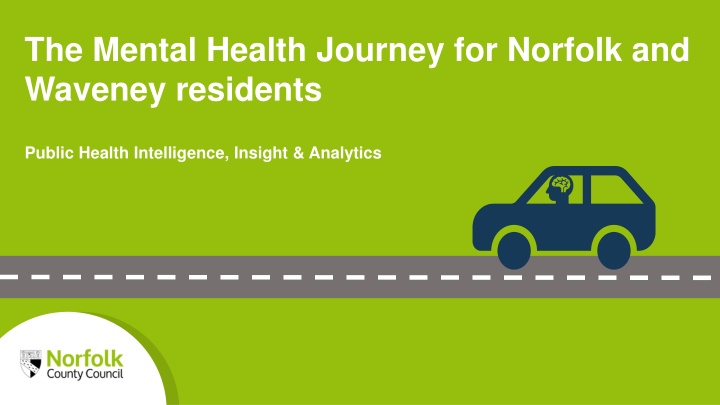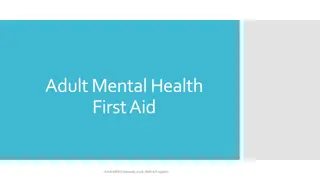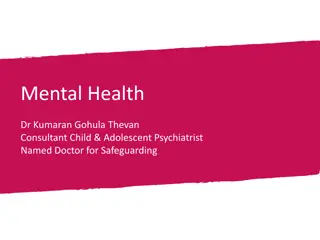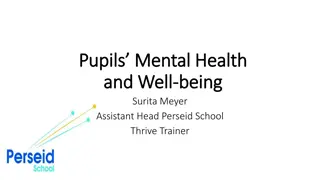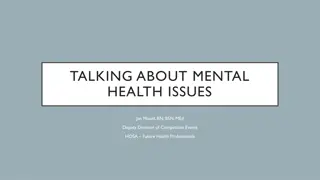The Mental Health Journey in Norfolk & Waveney
As mental health continues to impact residents in Norfolk and Waveney, various statistics reflect the prevalence and challenges faced. From suicide rates to parental struggles, the infographic sheds light on areas of concern and potential interventions. Insights from the data emphasize the importance of addressing mental health needs among different demographics and the significant role prevention plays in mitigating mental illness. By understanding the complex landscape of mental health in the region, strategies can be developed to support individuals and improve overall well-being.
Download Presentation

Please find below an Image/Link to download the presentation.
The content on the website is provided AS IS for your information and personal use only. It may not be sold, licensed, or shared on other websites without obtaining consent from the author.If you encounter any issues during the download, it is possible that the publisher has removed the file from their server.
You are allowed to download the files provided on this website for personal or commercial use, subject to the condition that they are used lawfully. All files are the property of their respective owners.
The content on the website is provided AS IS for your information and personal use only. It may not be sold, licensed, or shared on other websites without obtaining consent from the author.
E N D
Presentation Transcript
The Mental Health Journey for Norfolk and Waveney residents Public Health Intelligence, Insight & Analytics
Summary of Mental Health & Wellbeing in Norfolk and Waveney Who is most likely to be affected? What is the situation? Mental illness contributes to 21% of the total disease burdenin the UK Emotional wellbeing is a cause for concern for 46% of looked after children 3 76% of deaths due to suicide were among men 26% of peoplewith SMI* aresmokers3 (compared to 15% of the general population) People who are unemployed, which is 5% of the population 6%of children and adolescents haveemotional, social and mental health needs 64 per 10,000 of children are in care 1/3 of adults with mental health problems are parents Prevalence is increasing and is higher than national People with long-term conditions, 20% of people have a limiting long-term illness or disability3 People living in poverty, 15% of the population are fuel deprived3 average 16% of adults have diagnosed mental health conditions2 What are the impacts and risks? 59%in drug and alcohol treatment reported a mental health need (England) Self-reported mental illness ishigherthan national average, at 12%, identifying potential unmet needs Self-harm, excess alcohol and drug use account for more than half of emergency admissions for mental Rates per 100,000 population 395Hospital admissions 12 suicides Prevention due to self-harm (10-24 years)1 health Research suggests 25-50%of adult mental illness may be avoided through prevention and intervention in childhood Exposure to green, outdoor spaces and physical activity can improve mental health 32 per 1000 claim employment support The highest excess mental health admissions are in Lowestoft, Gorleston and Norwich allowance for mental & behavioural disorders 3 *Serious Mental Illness 1- Lower than national average 2- Similar to national average 3- Higher than national average Infographic produced by Insight & Analytics - April 2022. Data taken from Mental Health Needs Assessment . Data shown is for Norfolk and Waveney where possible, else is shown for Norfolk, unless stated otherwise e.g. national data.
Mental health is a state of wellbeing in which the individual realises his or her abilities, can cope with the normal stresses of life, can work productively and fruitfully and is able to make a contribution to his or her community Mental health is a state of wellbeing in which the individual realises his or her abilities, can cope with the normal stresses of life, can work productively and fruitfully and is able to make a contribution to his or her community (World Health Organisation) (World Health Organisation, 2018) Importance of mental health Mental wellbeing refers to: Feeling good Happiness, fulfilment, positive Mental illness has a can have a considerable impact on emotions Quality of life Functioning well Self-acceptance, personal growth, connection with others Nationally, mental health is one of the largest causes of illness These are periods of transition such as: Life course approach There are points in life when there are opportunities to promotemental wellbeing and intervene in at risk populations Redundancy Childhood becoming a new parent
Prevalence of Mental Ill Health Children & Young People Adults Anxietyand depression are more commonthan severe mental illness This is similar to national average Childhood and adolescence are important periods to improve mental health* 3% of school pupils have social, emotional and mental health needs This is higher than the national average and to be in line with it, there would be 665 fewer children with these needs. 75% of adults reporthigh levels of wellbeing 395 per 100,000 Hospital admissions due to self harm among 10-24-year-olds 12 Suicide deaths per 100,000 population This is higher than the national average, equating to approximately one extra death over a three year period This is equivalent to 575 annual admissions in Norfolk and is lower than the national average! * Excluding dementia
Promote Wellbeing Protective Factors for Mental Health & Wellbeing Levels of Activity School Readiness A measure of how prepared a child is to succeed in school cognitively, emotionally and socially Levels of wellbeing* A child s emotional health is a powerful predictor of their subsequent adult life satisfaction 76% of adults have high or very high life satisfaction* Activity can increase self-esteem and reducestress and anxiety 45% of children accumulate 60 minutes per day of activity 73%of children achieve this at the end of reception in Norfolk Similar to national average Similar to nationalaverage Similar to national average Outdoor space Exposure to green and outdoor spaces improve mental health A survey of students in year 3 11 scored 6.9 out of 10 for life satisfaction, happiness and worthwhileness 66% of adults are physically active 20% of the population use outdoor spaces for exercise Similar to national average Similar to nationalaverage Similar to national average *Wellbeing was measured as life satisfaction and happiness
Prevent Illness Risk Factors for Mental Illness Social Isolation Looked After Children 64 per 10,000of children in care services Poverty 15% of households live in fuel poverty Substance and alcohol 54% of adults in drug and alcohol treatment are parents/guardians 11%of children & 20% of adults feel lonely often This is similar to national average in low income and low energy efficiency homes. Norfolk is the bottom 40% of local authorities for fuel poverty This is 1,100 children in Norfolk and is similar to national average This is similar to national average Children in care are among the most socially excluded Their children are at increased risk of developing alcohol dependence & mental ill health Cold homes are associated with poor health It contributes to dementia Crime 141 per 100,000 first time entrants to youth justice system Homelessness 7.2per 1000 households owed a duty under Homelessness Reduction Act This is lower than national average Violence & Abuse 29 domestic abuse incidentsper 1000 people This is similar to national average Domestic abuse exposure impacts children s mental Unemployment 6% of young adults are not in education, employment or training This is similar to the national average Young people in youth justice system have higher mental health need This equates to 950 young adults and is similar to national average Increased risk of early parenthood and depression Poor mental health is a reason for homelessness health
Protect Health Outcomes for People Experiencing Mental Illness Smoking Life Expectancy Alcohol 10% 26% 457% of adults who entered treatment at alcohol misuse services were engaged in and mental health treatment This is similar to nationalaverage of adults with long-term mental health conditions are smokers This is 11% higher than the general population in Norfolk higher risk of premature mortality in those with SMI compared to those without* This is similar to nationalaverage People with SMI have a higher risk of physical illness compared to the general population Excess smoking contributes to the life expectancy gap Alcohol consumption is an important risk factor for mental illness Housing Employment Care Plan 71% 63% 32 per 1000 claim employment support allowance for mental and behavioural disorders of adults in contact with secondary mental health services lived in stable homes. This is 13% higher than the national average of diagnosed mental health patients have a comprehensive care plan This is 8% lower than the national average This is 5% higher than the national average People with mental illness are more likely to be in low paid, insecure employment or unemployed Care plans help people live an independent life Stable housing reduces risk of social exclusion SMI; Severe Mental Illness, ESA; Employment Support Allowance. *Premature mortality is those who died under age of 75
